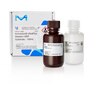MAFIP is a tumor suppressor in cervical cancer that inhibits activation of the nuclear factor-kappa B pathway.
Yang Li,Yao Yu,Yan Zhang,Yufei Zhou,Chao Li,Jianbing Zhu,Hanying Yuan,Hong Lu
Cancer science
102
2010
Afficher le résumé
Cervical cancer is the second most common cancer in women. Inactivation of tumor suppressor genes underlies the transformation and progression of cervical cancer. Previously, we reported MAFIP can inhibit the growth of human cervical cancer HeLa cells. In this study, MAFIP was found to be downregulated in cervical intraepithelial neoplasia tissues. Induced expression of MAFIP in HeLa cells strongly inhibited tumor formation in nude mice, confirming its tumor suppressor activity in vivo. Overexpression of MAFIP inhibited activation of the NF-κB pathway, a commonly active pathway in cancer cells, by preventing the phosphorylation of IKK and IκBα, degradation of IκBα and the nuclear localization of p65. Induction of c-myc, an oncogene controlled by NF-κB, was severely impaired in the cells overexpressing MAFIP. In contrast, knockdown of MAFIP by siRNA activated the NF-κB pathway and promoted cell proliferation. These data suggest MAFIP functions as a tumor suppressor in cervical cancer in part by inhibiting activation of the NF-κB pathway. | 21834855
 |
microRNA-141 is involved in a nasopharyngeal carcinoma-related genes network.
Zhang L, Deng T, Li X, Liu H, Zhou H, Ma J, Wu M, Zhou M, Shen S, Li X, Niu Z, Zhang W, Shi L, Xiang B, Lu J, Wang L, Li D, Tang H, Li G
Carcinogenesis
31
559-66 Epub 2010 Jan 6
2009
Afficher le résumé
microRNAs (miRNAs) are small non-coding RNAs and have been implicated in the pathology of various diseases, including cancer. Here we report that the miRNA profiles have been changed after knockdown of one of the most important oncogene c-MYC or re-expression of a candidate tumor suppressor gene SPLUNC1 in nasopharyngeal carcinoma (NPC) cells. Both c-MYC knockdown and SPLUNC1 re-expression can down-regulate microRNA-141 (miR-141). miR-141 is up-regulated in NPC specimens in comparison with normal nasopharyngeal epithelium. Inhibition of miR-141 could affect cell cycle, apoptosis, cell growth, migration and invasion in NPC cells. We found that BRD3, UBAP1 and PTEN are potential targets of miR-141, which had been confirmed following luciferase reporter assays and western blotting. BRD3 and UBAP1 are both involved in NPC carcinogenesis as confirmed through our previous studies and PTEN is a crucial tumor suppressor in many tumor types. BRD3 is involved in the regulation of the Rb/E2F pathway. Inhibition of miR-141 could affect some important molecules in the Rb/E2F, JNK2 and AKT pathways. It is well known that carcinogenesis of NPC is involved in the networks of genetic and epigenetic alteration events. We propose that miR-141- and tumor-related genes c-MYC, SPLUNC1, BRD3, UBAP1 and PTEN may constitute a gene-miRNA network to contribute to NPC development. | 20053927
 |
A sensitive and quantitative enzyme-linked immunosorbence assay for the c-myc and N-myc oncoproteins.
Moore, J P, et al.
Oncogene Res., 2: 65-80 (1987)
1987
Afficher le résumé
The c-myc and N-myc nuclear oncoproteins are implicated in the genesis and maintenance of the transformed phenotype in several types of neoplastic disease, and the c-myc protein is involved in the progression of normal cells through the cell cycle. We have designed and developed sensitive and quantitative ELISAs for these proteins. Myc proteins are captured from cell lysates by an antibody directed against a peptide sequence substantially conserved in all known myc proteins; the captured proteins are recognised by a specific anti-c-myc or anti-N-myc monoclonal antibody conjugated to alkaline phosphatase; bound alkaline phosphatase is measured with an extremely sensitive cycling enzyme system that generates a coloured end-product. The c-myc assay is calibrated using bacterially expressed human c-myc protein. We have used this assay to estimate the number of c-myc molecules in a range of normal and transformed cells of human, murine, and feline origin; to monitor increases in c-myc expression when quiescent cells are stimulated with growth factors; and to follow the decrease in c-myc protein levels when HL60 promyelocytic leukaemia cells are induced to differentiate with dimethylsulphoxide or phorbol esters. | 3333275
 |
Isolation of monoclonal antibodies specific for human c-myc proto-oncogene product.
Evan, G I, et al.
Mol. Cell. Biol., 5: 3610-6 (1985)
1985
Afficher le résumé
Six monoclonal antibodies have been isolated from mice immunized with synthetic peptide immunogens whose sequences are derived from that of the human c-myc gene product. Five of these antibodies precipitate p62c-myc from human cells, and three of these five also recognize the mouse c-myc gene product. None of the antibodies sees the chicken p110gag-myc protein. All six antibodies recognize immunoblotted p62c-myc. These reagents also provide the basis for an immunoblotting assay by which to quantitate p62c-myc in cells. | 3915782
 |





















